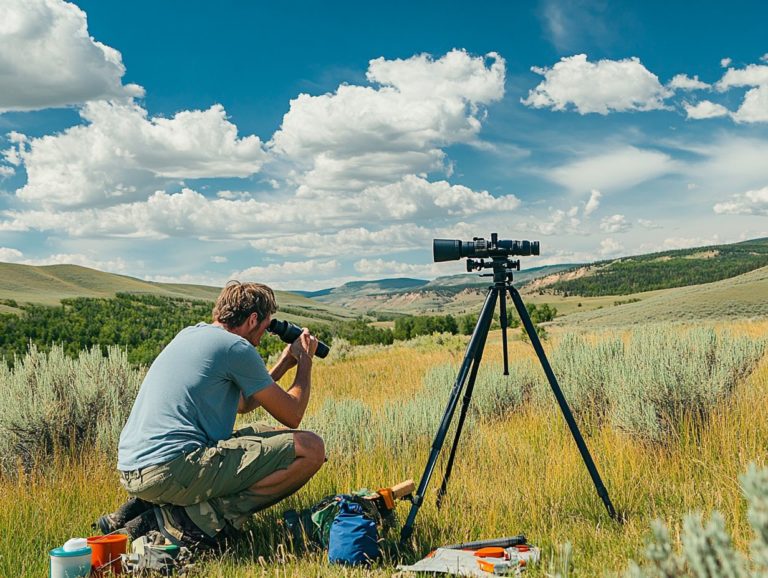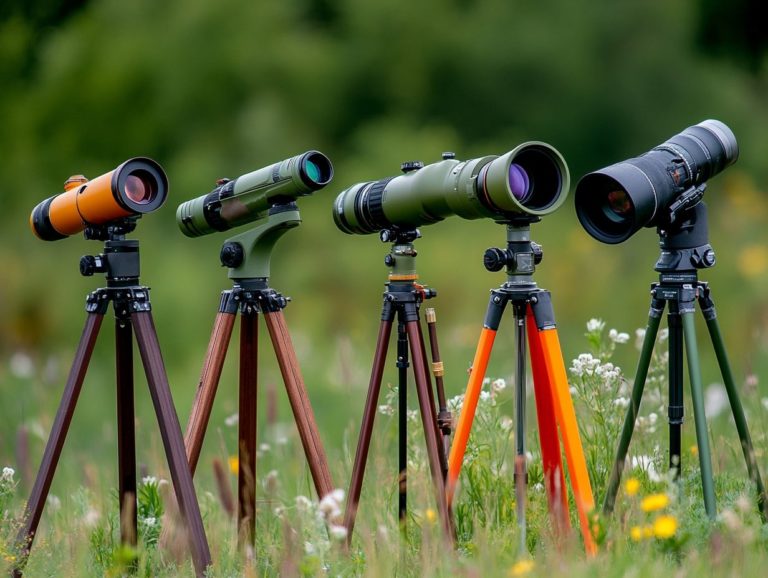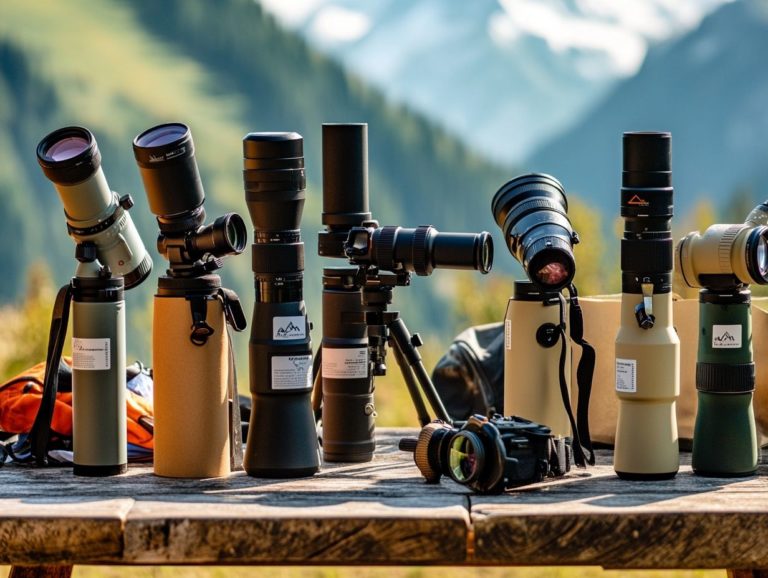Field Testing Your Spotting Scope: What to Know
Ready to elevate your outdoor adventures? Selecting the perfect spotting scope is your first step!
Choosing the right spotting scope can profoundly enhance your outdoor experiences, whether you re birdwatching, hunting, or enjoying nature.
This article explains the importance of field testing. We will guide you through selecting a suitable scope and preparing for effective testing.
You will discover the essential gear needed and follow a simple step-by-step guide for conducting your tests.
By the end, you will have the insights to make precise adjustments and avoid common pitfalls. This ensures your field testing is a success!
Contents
- Key Takeaways:
- Choosing the Right Spotting Scope for Your Needs
- Preparing for Field Testing
- Conducting Field Tests
- Interpreting Results and Adjusting Your Scope
- Tips for Successful Field Testing
- Frequently Asked Questions
- What is field testing for a spotting scope?
- Why is field testing important for a spotting scope?
- What are some factors to consider when field testing a spotting scope?
- How do I properly field test a spotting scope?
- What are some common issues to look for when field testing a spotting scope?
- Do I need any special equipment for field testing my spotting scope?
Key Takeaways:
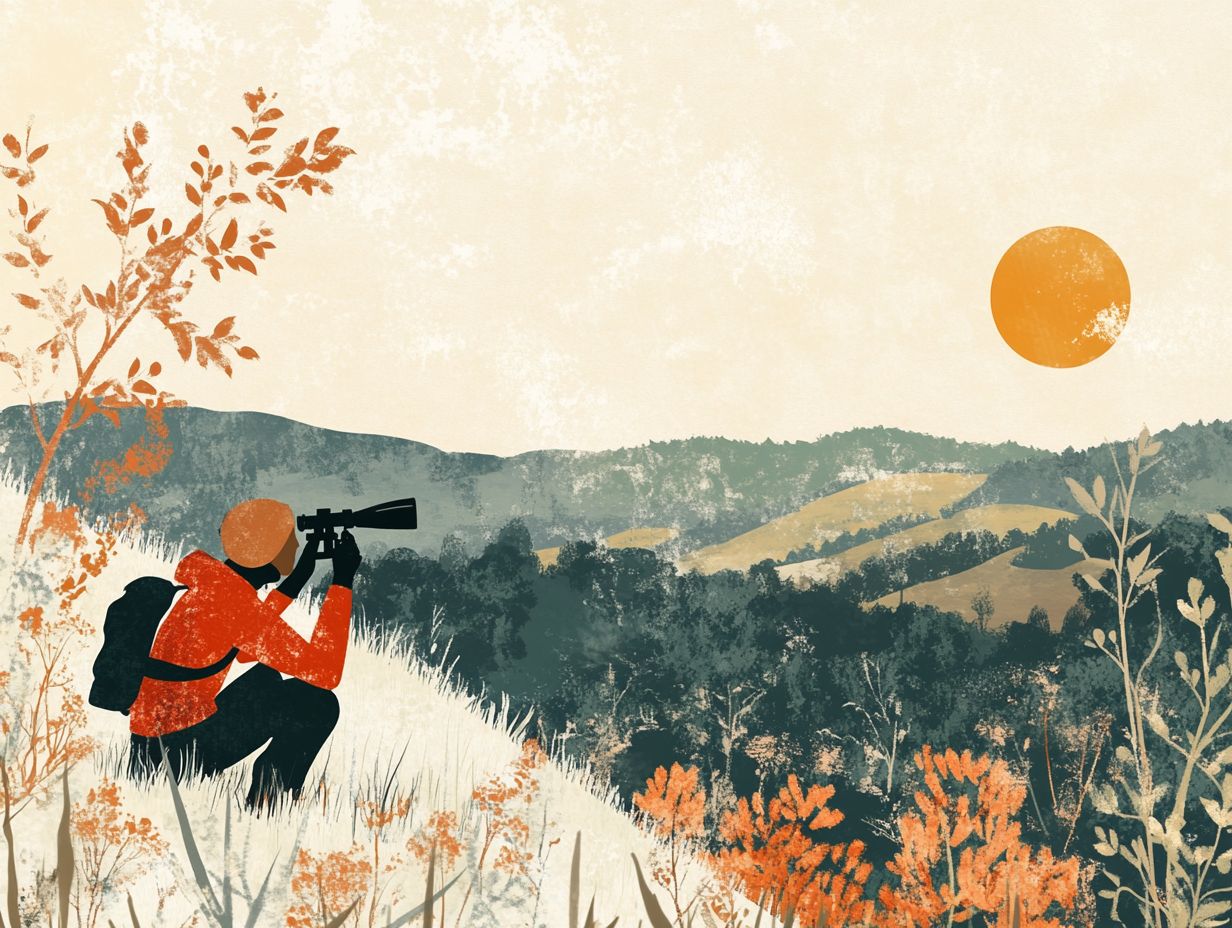
- Field testing is vital to confirm your spotting scope meets your needs.
- Consider magnification, lens size, and waterproofing when choosing a spotting scope.
- Preparation and a step-by-step guide are essential for successful field tests.
Why Field Testing is Important
Field testing is essential for you to determine the effectiveness and performance of a spotting scope in real-world conditions. This hands-on approach allows you to assess its quality and suitability for various observation tasks, helping you learn how to make the most of your spotting scope setup.
By carefully testing different models, you can gain valuable insights into the sharpness, brightness, and overall optics tailored to specific activities like birdwatching, which often demands high standards in magnification and clarity.
This evaluation provides a comprehensive understanding of how different features impact your observation experience. Consider factors such as lens coatings and field of view; these elements can enhance or hinder your ability to identify distant subjects.
Engaging in real-world testing allows you to interact with the scope across various lighting conditions and terrains. This process enables you to make informed decisions, ensuring you select the right tool for your individual needs, ultimately enriching your overall viewing pleasure.
Choosing the Right Spotting Scope for Your Needs
Choosing the right spotting scope is crucial for achieving optimal performance that aligns perfectly with your specific observation needs, especially in pursuits like birdwatching or long-range viewing.
You ll want to consider factors like price, magnification range, and the quality of the eyepiece. These elements will significantly influence which model meets your expectations.
Waterproofing features enhance the scope’s durability and functionality across various environments, ensuring you re equipped for any adventure.
Factors to Consider
When choosing a spotting scope, consider various factors like quality, performance, and magnification to find a model that suits your observation style. Pay attention to the eyepiece design; it can greatly impact your viewing experience.
Remember, the price tag often reflects the scope s overall quality and durability, including essential waterproof features for outdoor adventures.
Higher magnification levels might promise stunning details from afar, but they can also introduce instability and reduce your field of view, making it tricky to track moving subjects. The type of eyepiece whether it s fixed or zoom will also affect your adaptability during observations.
Opting for a brand with a solid reputation for reliability can truly elevate your experience. Established brands usually back their products with warranties and customer service that offer invaluable peace of mind.
Considering all these elements will create a richly rewarding viewing experience that enhances your enjoyment and satisfaction.
Preparing for Field Testing
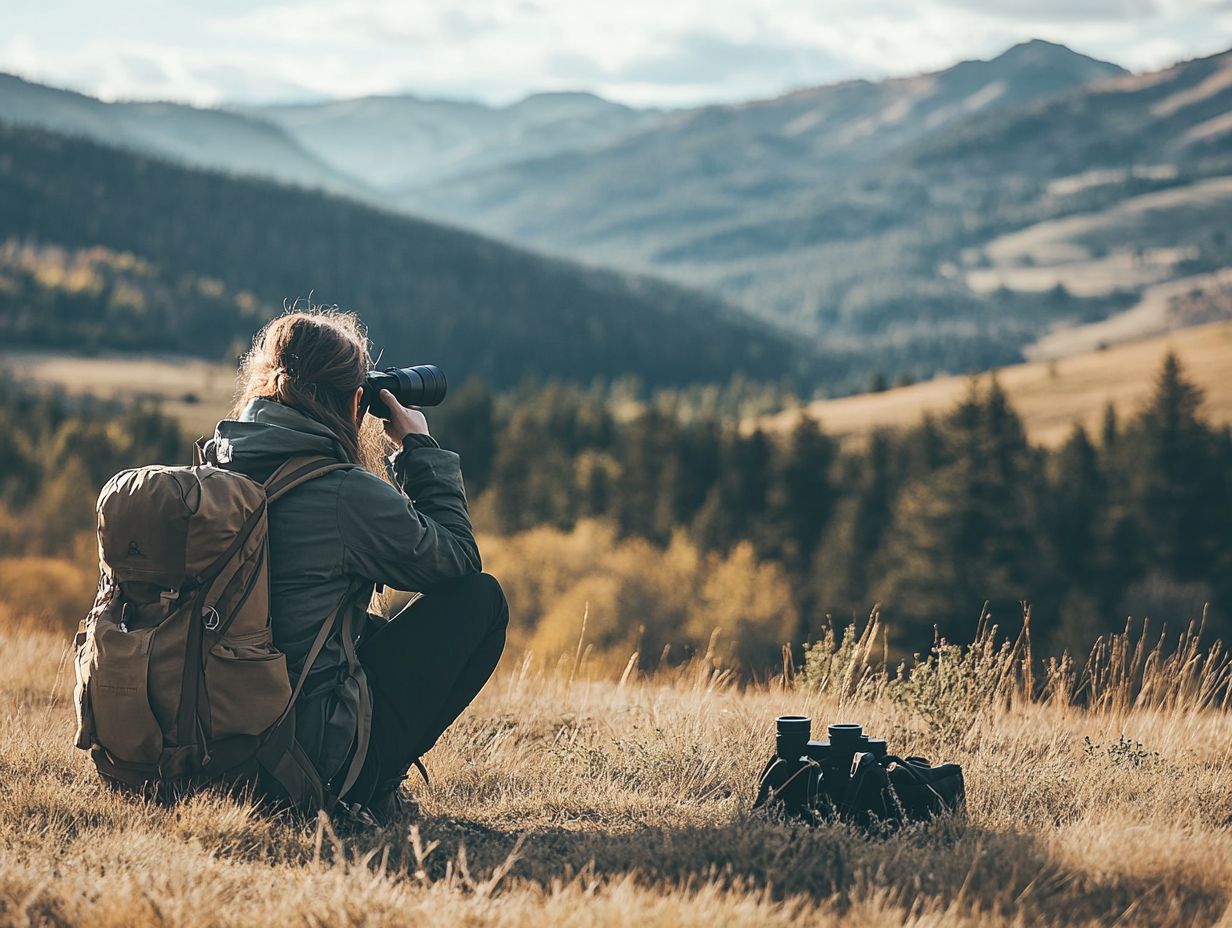
Preparing for field testing a spotting scope requires gathering essential gear and tools. For beginners, spotting scope use tips can help establish a clear observation method to ensure accurate results.
This thoughtful preparation enhances your ability to assess the scope’s performance in various conditions. You’ll be enabled to make informed decisions about its quality for activities like birdwatching or wildlife observation.
Essential Gear and Tools
Key items for field testing a spotting scope include a sturdy tripod and a flashlight for low-light conditions. Additionally, a quality notebook will help you record important observations, while understanding how to use spotting scopes for nature observation can enhance your experience.
A lens cleaner greatly enhances clarity during observations. A comfortable backpack will make transporting your gear easier as you explore diverse terrains.
Using a rangefinder helps achieve accuracy with precise distance measurements. Each tool contributes to a thorough testing environment, supporting comprehensive observations.
Conducting Field Tests
Field testing your spotting scope? A systematic approach is your secret weapon! For more insights, refer to our spotting scope buying guide to assess various factors based on a clear method to gauge performance effectively.
Use a structured testing process to uncover valuable insights into the scope s capabilities, such as clarity and brightness. These elements are crucial for outdoor adventures.
Step-by-Step Guide
A step-by-step guide requires careful planning to evaluate performance under real-world conditions. This approach allows you to gather objective data on each model.
Start by identifying diverse testing locations, like open fields and wooded areas. Establish a consistent way to measure performance metrics, such as clarity at different distances.
When comparing results, consider your short-term impressions and long-term usability. Document your observations accurately for meaningful insights in your selection process.
Interpreting Results and Adjusting Your Scope

Interpreting field test results is essential for pinpointing areas for improvement. Analyze key metrics like sharpness and brightness to customize your scope for optimal performance.
Make adjustments to meet your specific needs for activities such as birdwatching or outdoor exploration. Ensure your scope functions at its best for every adventure!
How to Make Necessary Adjustments
Making necessary adjustments to your spotting scope involves fine-tuning various parameters to elevate its overall performance and quality. For comprehensive guidance, learn how to choose the right spotting scope for you and draw insights from your field tests.
You can modify elements such as focus, eyepiece settings, and even the scope’s positioning to enhance clarity and brightness during observation. This ultimately leads to a superior viewing experience.
Adjusting the objective lens can have a remarkable impact on light transmission, resulting in brighter images, particularly in low-light conditions.
By experimenting with different magnification levels, you can discover the optimal range that strikes a balance between depth of field (the range of distance within a photo that appears sharp) and image stability.
Utilizing a sturdy tripod not only minimizes vibrations but also aids in precise aiming, which is essential for those extended viewing sessions. Consider the atmospheric conditions when making these adjustments; a mirage can distort images, and a slight change in the angle of your scope can yield a notable difference in clarity.
Implementing these strategies will ensure that each observation is as clear and detailed as possible, allowing you to fully enjoy every moment in the field.
Tips for Successful Field Testing
To achieve successful field testing of spotting scopes, follow essential tips that foster effective observation and enable accurate assessments of performance, including the step-by-step guide for setting up your spotting scope.
By being aware of common pitfalls, such as subpar lighting conditions or insufficient setup, you can greatly enhance your testing results and acquire valuable insights into the scope’s quality and functionality.
Best Practices and Common Mistakes to Avoid
Implementing best practices during your field tests of spotting scopes is crucial for achieving reliable results and maximizing the quality of your observations. Make sure to consider the factors outlined in our guide on spotting scope selection.
By avoiding common pitfalls like neglecting proper equipment setup or overlooking environmental factors you can significantly enhance how well the scope works.
Explore different lighting conditions for a complete understanding of your scope’s capabilities. Engaging in side-by-side comparisons with other models can reveal subtle differences in clarity and focus that might easily slip under the radar.
Pay close attention to factors like stability and ease of adjustment to greatly influence your overall experience. Don’t forget to meticulously document your observations; this will allow you to track performance trends over time, enabling you to make informed decisions when selecting the ideal scope for your specific needs.
Frequently Asked Questions
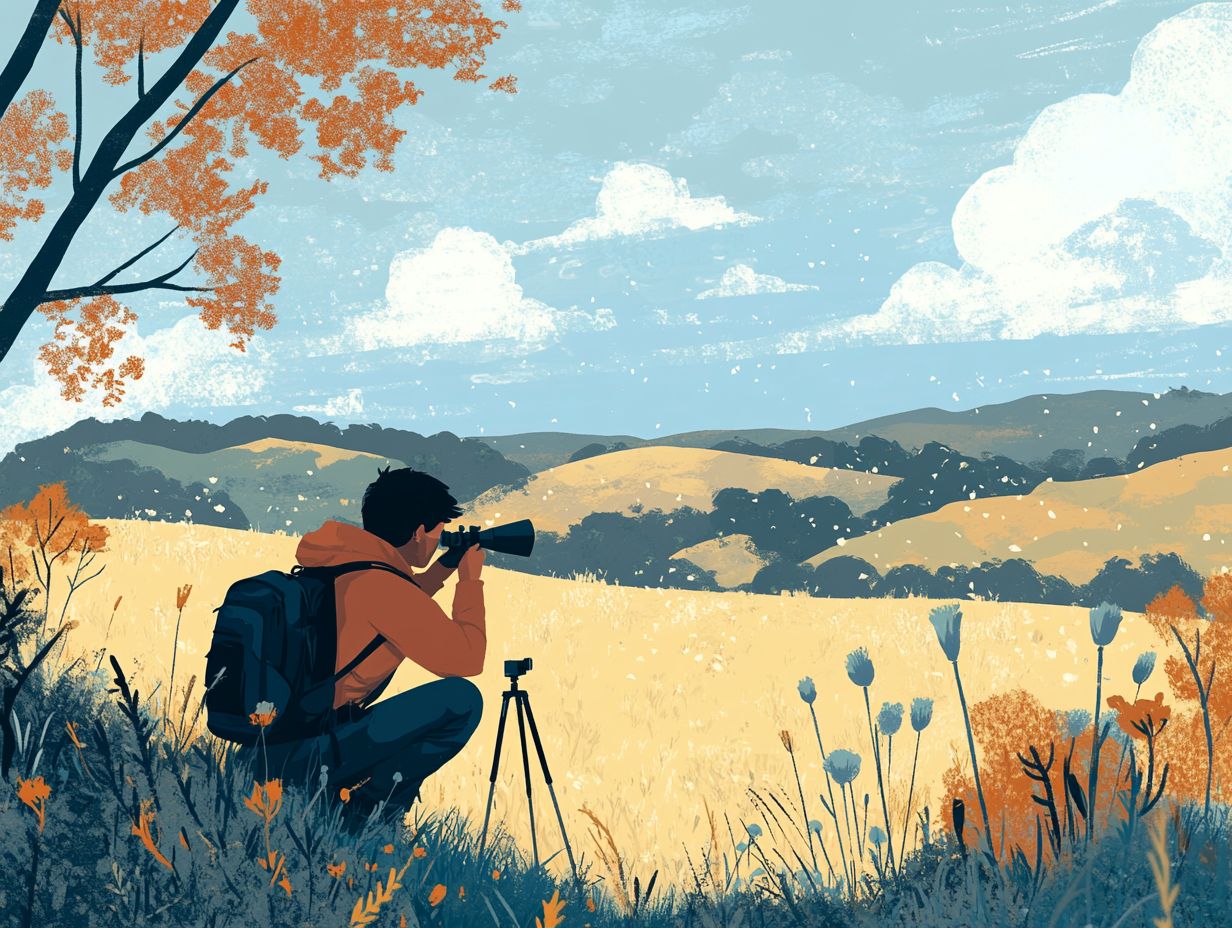
What is field testing for a spotting scope?
Field testing for a spotting scope involves taking the device out into the field to evaluate its performance and functionality in real-world conditions. For those new to this equipment, understanding spotting scopes can greatly enhance your experience.
Why is field testing important for a spotting scope?
Field testing allows you to see how the spotting scope performs in different lighting and weather conditions. Additionally, it helps you understand how to find the right spotting scope for your needs by assessing its ease of use and durability in outdoor environments.
What are some factors to consider when field testing a spotting scope?
Some important factors to consider include magnification power, image clarity, focus ability, and portability.
How do I properly field test a spotting scope?
To properly field test a spotting scope, start by setting it up in a comfortable and stable position. Then, adjust the magnification and focus to your desired settings and understand the basics of spotting scope optics by observing different objects in various lighting conditions.
What are some common issues to look for when field testing a spotting scope?
Be on the lookout for any issues with image distortion, lens quality, or user-friendly features like eyepiece adjustments or tripod compatibility.
Do I need any special equipment for field testing my spotting scope?
It is recommended to bring a tripod or other stabilizing device for the most accurate results. You may also want to bring different types of objects to observe, such as birds or distant landscapes.
Have more questions about field testing? Share your thoughts with us!

